The Feasibility of a Continental Breakfast Service in Ghana by 2017
VerifiedAdded on 2020/01/07
|53
|16986
|520
Thesis and Dissertation
AI Summary
This thesis presents a comprehensive feasibility study for a continental breakfast service in Ghana, focusing on the year 2017. It begins with an introduction to the business concept, including a general description, product and service offerings (Tom brown, wheat porridge, rice porridge, etc.), vision, mission, goals, target market (middle-income city dwellers in Accra and Tema), value proposition, and specific features such as home delivery and hygienic preparation. The study then delves into feasibility research, covering product, industry (Porter's Five Forces), market (size of potential customers), organizational (required skills), and financial aspects (start-up capital, operating costs, profit and loss, cash flow). A detailed business model is presented, including strategic analysis (PESTLE, SWOT, M's model), strategy selection (Porters generic and Blue Ocean), and a business canvas model. The business plan encompasses industry and market analysis, marketing strategies, marketing plan, organizational plan, operational plan, risk assessment, and financial projections. The analysis includes Ansoff Matrix, marketing segmentation, and a timetable for operations, concluding with financial needs and assumptions. The research is based on secondary sources and aims to provide a sustainable business model for MAG Food and Delivery Services Limited.
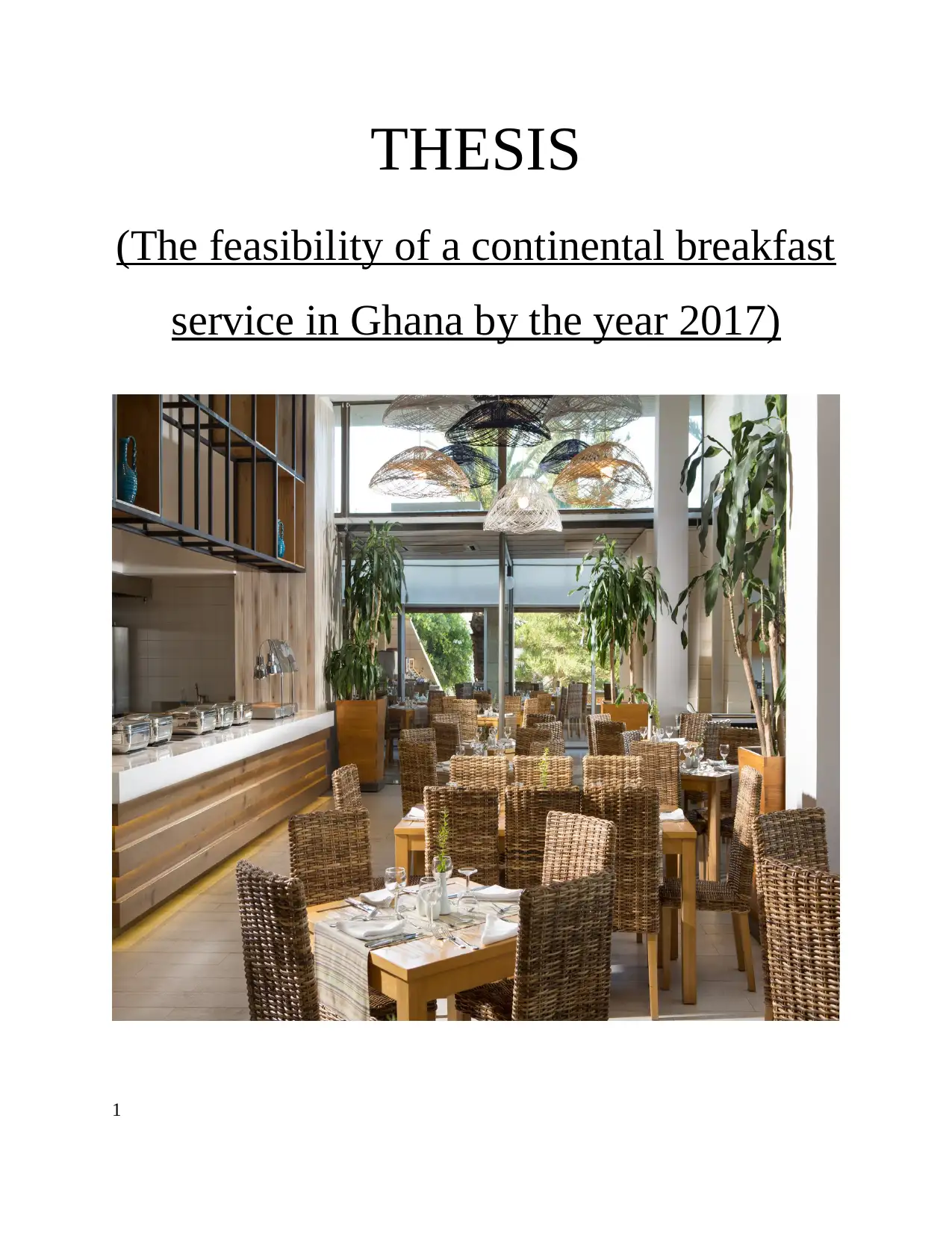
THESIS
(The feasibility of a continental breakfast
service in Ghana by the year 2017)
1
(The feasibility of a continental breakfast
service in Ghana by the year 2017)
1
Paraphrase This Document
Need a fresh take? Get an instant paraphrase of this document with our AI Paraphraser
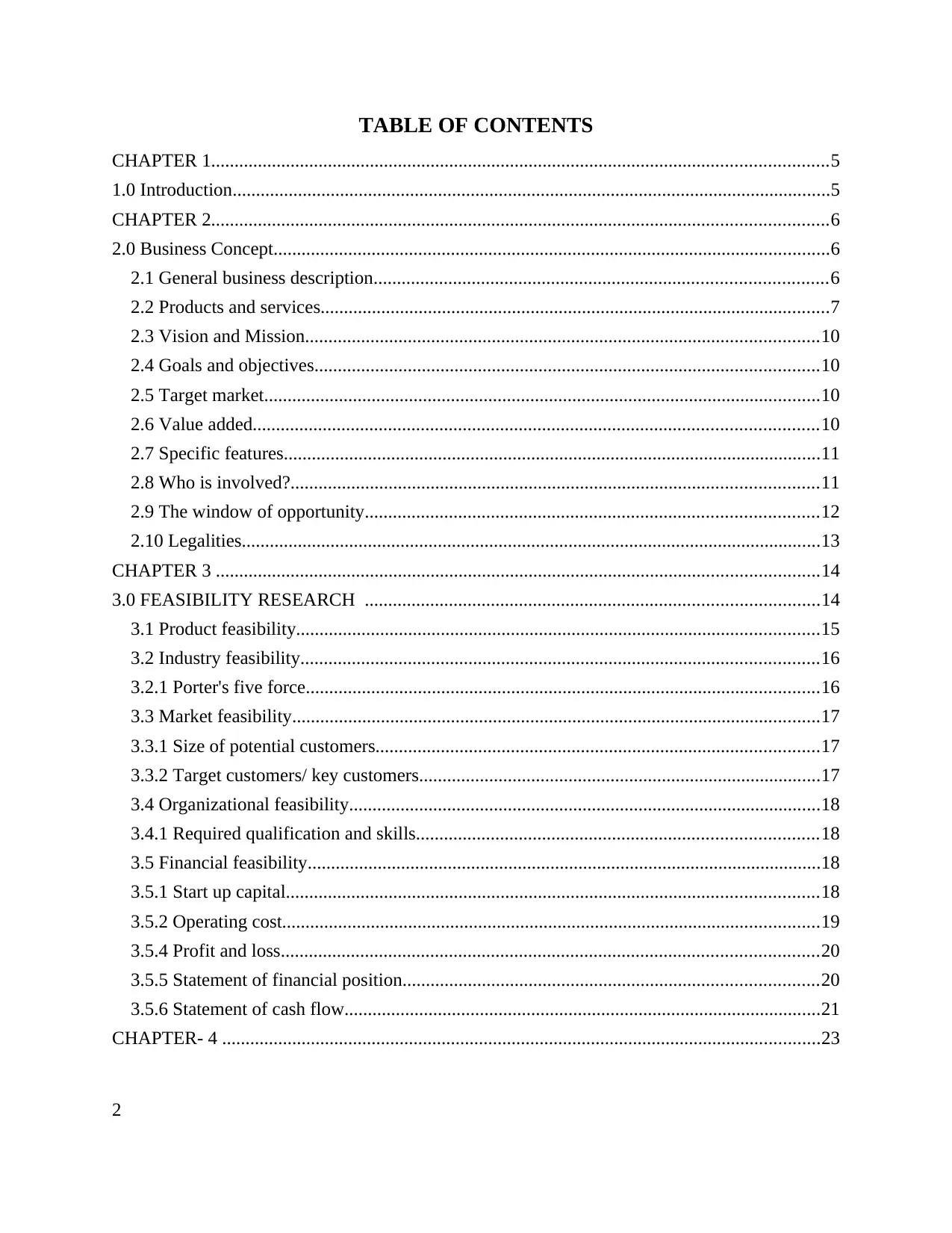
TABLE OF CONTENTS
CHAPTER 1....................................................................................................................................5
1.0 Introduction................................................................................................................................5
CHAPTER 2....................................................................................................................................6
2.0 Business Concept.......................................................................................................................6
2.1 General business description.................................................................................................6
2.2 Products and services.............................................................................................................7
2.3 Vision and Mission..............................................................................................................10
2.4 Goals and objectives............................................................................................................10
2.5 Target market.......................................................................................................................10
2.6 Value added.........................................................................................................................10
2.7 Specific features...................................................................................................................11
2.8 Who is involved?.................................................................................................................11
2.9 The window of opportunity.................................................................................................12
2.10 Legalities............................................................................................................................13
CHAPTER 3 .................................................................................................................................14
3.0 FEASIBILITY RESEARCH .................................................................................................14
3.1 Product feasibility................................................................................................................15
3.2 Industry feasibility...............................................................................................................16
3.2.1 Porter's five force..............................................................................................................16
3.3 Market feasibility.................................................................................................................17
3.3.1 Size of potential customers...............................................................................................17
3.3.2 Target customers/ key customers......................................................................................17
3.4 Organizational feasibility.....................................................................................................18
3.4.1 Required qualification and skills......................................................................................18
3.5 Financial feasibility..............................................................................................................18
3.5.1 Start up capital..................................................................................................................18
3.5.2 Operating cost...................................................................................................................19
3.5.4 Profit and loss...................................................................................................................20
3.5.5 Statement of financial position.........................................................................................20
3.5.6 Statement of cash flow......................................................................................................21
CHAPTER- 4 ................................................................................................................................23
2
CHAPTER 1....................................................................................................................................5
1.0 Introduction................................................................................................................................5
CHAPTER 2....................................................................................................................................6
2.0 Business Concept.......................................................................................................................6
2.1 General business description.................................................................................................6
2.2 Products and services.............................................................................................................7
2.3 Vision and Mission..............................................................................................................10
2.4 Goals and objectives............................................................................................................10
2.5 Target market.......................................................................................................................10
2.6 Value added.........................................................................................................................10
2.7 Specific features...................................................................................................................11
2.8 Who is involved?.................................................................................................................11
2.9 The window of opportunity.................................................................................................12
2.10 Legalities............................................................................................................................13
CHAPTER 3 .................................................................................................................................14
3.0 FEASIBILITY RESEARCH .................................................................................................14
3.1 Product feasibility................................................................................................................15
3.2 Industry feasibility...............................................................................................................16
3.2.1 Porter's five force..............................................................................................................16
3.3 Market feasibility.................................................................................................................17
3.3.1 Size of potential customers...............................................................................................17
3.3.2 Target customers/ key customers......................................................................................17
3.4 Organizational feasibility.....................................................................................................18
3.4.1 Required qualification and skills......................................................................................18
3.5 Financial feasibility..............................................................................................................18
3.5.1 Start up capital..................................................................................................................18
3.5.2 Operating cost...................................................................................................................19
3.5.4 Profit and loss...................................................................................................................20
3.5.5 Statement of financial position.........................................................................................20
3.5.6 Statement of cash flow......................................................................................................21
CHAPTER- 4 ................................................................................................................................23
2

4.0 BUSINESS MODEL...............................................................................................................23
4.1 Introduction to business model............................................................................................23
4.2 Strategic analysis of business idea.......................................................................................24
4.3 PESTLE analysis.................................................................................................................25
4.4 SWOT analysis ...................................................................................................................26
4.5 M's model analysis...............................................................................................................27
4.6 Selection of possible strategies ...........................................................................................28
4.6.1 Porters generic..................................................................................................................28
4.6.2 Blue ocean strategy...........................................................................................................29
4.7 Development of appropriate business model.......................................................................30
4.7.1 Business canvas model.....................................................................................................30
CHAPTER -5 ................................................................................................................................33
5.0 business plan ...........................................................................................................................33
5.1 Industry analysis..................................................................................................................33
5.2 Ansoff Matrix......................................................................................................................33
5.3 Market analysis ...................................................................................................................34
5.4 Key customers......................................................................................................................35
5.5 Marketing plan ....................................................................................................................36
5.5.1 Marketing strategy............................................................................................................36
5.5.2 Marketing methods...........................................................................................................36
5.5.3 Marketing communication................................................................................................37
5.5.4 Distribution system...........................................................................................................38
5.5.5 Life cycle changes in the use of marketing mix ..............................................................39
5.5.6 Marketing segmentation...................................................................................................41
5.6 Organizational plan .............................................................................................................42
5.6.1 Ownership structure..........................................................................................................42
5.6.2 Management team background ........................................................................................42
5.6.3 Human resource management...........................................................................................43
5.7 Operation plan .....................................................................................................................44
5.7.1 Location............................................................................................................................44
5.7.2 Flow of orders for goods and services..............................................................................44
5.7.3 Technology utilization......................................................................................................45
5.8 Risk assessment...................................................................................................................45
3
4.1 Introduction to business model............................................................................................23
4.2 Strategic analysis of business idea.......................................................................................24
4.3 PESTLE analysis.................................................................................................................25
4.4 SWOT analysis ...................................................................................................................26
4.5 M's model analysis...............................................................................................................27
4.6 Selection of possible strategies ...........................................................................................28
4.6.1 Porters generic..................................................................................................................28
4.6.2 Blue ocean strategy...........................................................................................................29
4.7 Development of appropriate business model.......................................................................30
4.7.1 Business canvas model.....................................................................................................30
CHAPTER -5 ................................................................................................................................33
5.0 business plan ...........................................................................................................................33
5.1 Industry analysis..................................................................................................................33
5.2 Ansoff Matrix......................................................................................................................33
5.3 Market analysis ...................................................................................................................34
5.4 Key customers......................................................................................................................35
5.5 Marketing plan ....................................................................................................................36
5.5.1 Marketing strategy............................................................................................................36
5.5.2 Marketing methods...........................................................................................................36
5.5.3 Marketing communication................................................................................................37
5.5.4 Distribution system...........................................................................................................38
5.5.5 Life cycle changes in the use of marketing mix ..............................................................39
5.5.6 Marketing segmentation...................................................................................................41
5.6 Organizational plan .............................................................................................................42
5.6.1 Ownership structure..........................................................................................................42
5.6.2 Management team background ........................................................................................42
5.6.3 Human resource management...........................................................................................43
5.7 Operation plan .....................................................................................................................44
5.7.1 Location............................................................................................................................44
5.7.2 Flow of orders for goods and services..............................................................................44
5.7.3 Technology utilization......................................................................................................45
5.8 Risk assessment...................................................................................................................45
3
⊘ This is a preview!⊘
Do you want full access?
Subscribe today to unlock all pages.

Trusted by 1+ million students worldwide
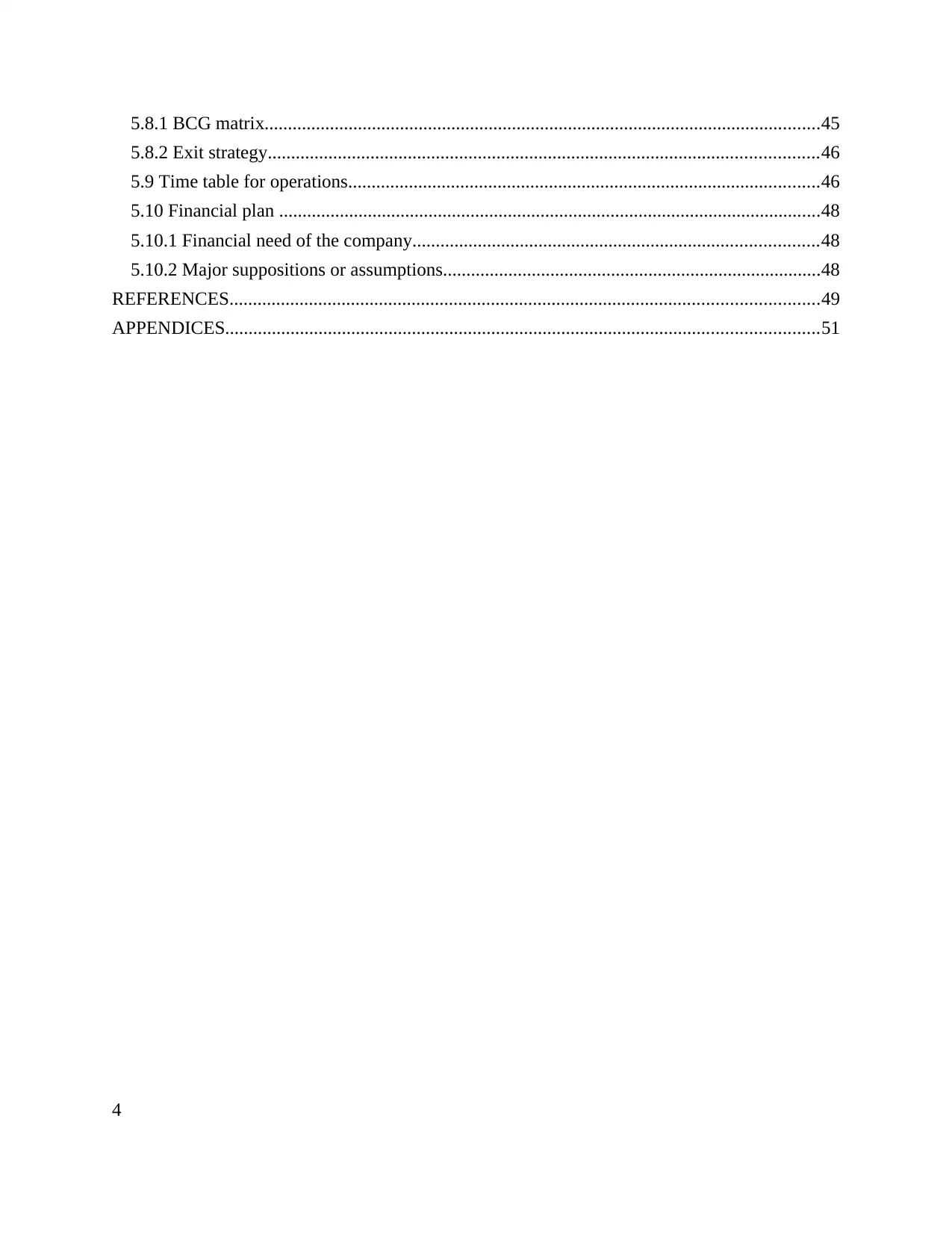
5.8.1 BCG matrix.......................................................................................................................45
5.8.2 Exit strategy......................................................................................................................46
5.9 Time table for operations.....................................................................................................46
5.10 Financial plan ....................................................................................................................48
5.10.1 Financial need of the company.......................................................................................48
5.10.2 Major suppositions or assumptions.................................................................................48
REFERENCES..............................................................................................................................49
APPENDICES...............................................................................................................................51
4
5.8.2 Exit strategy......................................................................................................................46
5.9 Time table for operations.....................................................................................................46
5.10 Financial plan ....................................................................................................................48
5.10.1 Financial need of the company.......................................................................................48
5.10.2 Major suppositions or assumptions.................................................................................48
REFERENCES..............................................................................................................................49
APPENDICES...............................................................................................................................51
4
Paraphrase This Document
Need a fresh take? Get an instant paraphrase of this document with our AI Paraphraser

CHAPTER 1
1.0 INTRODUCTION
Urban migration has brought immense implications on business activities in the cities of
many countries. As of 2010, urban dwellers constitute 64% of the total population in Ghana.
Workers in all fields thus have to wake up very early to avoid being late to work as a result of
intense traffic. This daily routine has made it more difficult for most workers who have busy
schedules to have breakfast before starting the day’s work. This has created avenues for private
breakfast services to provide breakfast services for workers at various food stands in the city.
Workers, however, still form queues to get their breakfast at the various standpoints as a result of
increasing demands leading most of them to forfeit breakfast for fear of reporting late at work.
For this reason, MAG Breakfast intends to meet this rising demand by providing “at your
doorstep” delivery services comprising breakfast ranging from cereal, grain and porridge.
For the purpose of completing the proposal successfully the conditions of the market as
well as industry is being analyzed in an effective manner. Further detail expenses in relation to
the start up is being outlined. The present plan is comprised of detailed market, organizational,
operational and financial plan. At last implementation of timetable would also be developed. The
proposal is secondary research as such the feasibility study carried out is on the basis of
information gained from primary investigation of other authors. An internal and external
secondary sources from reports, the market and industry data bases, government statistics and
other information sources are collected, compared as well analyzed in order to make
determination of the feasibility of MAG Food and Delivery Services Limited.
Relevant model that includes PESTLE analysis, porters five force, SWOT analysis,
business canvas model and the product and industry life cycle model are being implemented in
the present proposal so as to make sure that positive results are obtained by organization. Te
proposed business aims at starting operations in 2017. It is being assumed that by the end of first
year the business would make profitability which will assist it in sustaining operations for the
coming years. Thus it will not fail. Each part of the present proposal aims at assisting the
business to be executed and survive in long run course of time.
5
1.0 INTRODUCTION
Urban migration has brought immense implications on business activities in the cities of
many countries. As of 2010, urban dwellers constitute 64% of the total population in Ghana.
Workers in all fields thus have to wake up very early to avoid being late to work as a result of
intense traffic. This daily routine has made it more difficult for most workers who have busy
schedules to have breakfast before starting the day’s work. This has created avenues for private
breakfast services to provide breakfast services for workers at various food stands in the city.
Workers, however, still form queues to get their breakfast at the various standpoints as a result of
increasing demands leading most of them to forfeit breakfast for fear of reporting late at work.
For this reason, MAG Breakfast intends to meet this rising demand by providing “at your
doorstep” delivery services comprising breakfast ranging from cereal, grain and porridge.
For the purpose of completing the proposal successfully the conditions of the market as
well as industry is being analyzed in an effective manner. Further detail expenses in relation to
the start up is being outlined. The present plan is comprised of detailed market, organizational,
operational and financial plan. At last implementation of timetable would also be developed. The
proposal is secondary research as such the feasibility study carried out is on the basis of
information gained from primary investigation of other authors. An internal and external
secondary sources from reports, the market and industry data bases, government statistics and
other information sources are collected, compared as well analyzed in order to make
determination of the feasibility of MAG Food and Delivery Services Limited.
Relevant model that includes PESTLE analysis, porters five force, SWOT analysis,
business canvas model and the product and industry life cycle model are being implemented in
the present proposal so as to make sure that positive results are obtained by organization. Te
proposed business aims at starting operations in 2017. It is being assumed that by the end of first
year the business would make profitability which will assist it in sustaining operations for the
coming years. Thus it will not fail. Each part of the present proposal aims at assisting the
business to be executed and survive in long run course of time.
5

CHAPTER 2
2.0 BUSINESS CONCEPT
2.1 General business description
MAG food and delivery services Ltd. is a start-up company which focuses mainly on
providing high quality but affordable breakfast services in urban areas in Ghana. MAG food and
delivery services Ltd. is sole-proprietorship business. The company is owned by Maame
Gyamfua Obeng-Agyemang and intends to provide breakfast delivery services to workers of
various fields; Corporate bodies, Schools, Construction and manufacturing firms etc. The firm is
small business that is aiming to satisfy the requirement of huge customer base in an effective
manner. The firm intends to provide quality and affordable breakfast services to the customers.
At present the firm desires to introduce new range of breakfasts products for the customers. The
new business is concerned towards enhancing the market share through the means of introducing
new range of products. The organization is dedicated towards offering new products as well as
services to the areas where there is need. MAG food and delivery services Ltd. has came into
existence to offer breakfasts services at economical prices. The organization is wishing to make
suitable relationship with customers, suppliers as well as personnel that can provide value to the
interests and objectives of each party. The organization aims at offering greater satisfaction level
to the customers that will facilitate in increasing awareness of the organization within the market.
Along with this such will enhance the base of customers for the organization to a significant
level. The present concept of the business is being devised in order to serve the recent growing
requirements of the market with greater effectiveness (Anderson and Khedair, 2009). The main
aim is to provide the customers with affordable prices and greater breakfast products at a specific
location. Thus quality with convenience is provided to the customers.
Urban Areas in the Greater Accra region constitute the initial target market for Mag Ltd.
These areas are highly concentrated with corporations of different charters. The demand for
quality but affordable breakfast keeps rising with few service providers such as Koko King
meeting this demand. Alternative means of getting breakfast are the “road side” vendors,
however their quality and hygienic standards remain questionable.
6
2.0 BUSINESS CONCEPT
2.1 General business description
MAG food and delivery services Ltd. is a start-up company which focuses mainly on
providing high quality but affordable breakfast services in urban areas in Ghana. MAG food and
delivery services Ltd. is sole-proprietorship business. The company is owned by Maame
Gyamfua Obeng-Agyemang and intends to provide breakfast delivery services to workers of
various fields; Corporate bodies, Schools, Construction and manufacturing firms etc. The firm is
small business that is aiming to satisfy the requirement of huge customer base in an effective
manner. The firm intends to provide quality and affordable breakfast services to the customers.
At present the firm desires to introduce new range of breakfasts products for the customers. The
new business is concerned towards enhancing the market share through the means of introducing
new range of products. The organization is dedicated towards offering new products as well as
services to the areas where there is need. MAG food and delivery services Ltd. has came into
existence to offer breakfasts services at economical prices. The organization is wishing to make
suitable relationship with customers, suppliers as well as personnel that can provide value to the
interests and objectives of each party. The organization aims at offering greater satisfaction level
to the customers that will facilitate in increasing awareness of the organization within the market.
Along with this such will enhance the base of customers for the organization to a significant
level. The present concept of the business is being devised in order to serve the recent growing
requirements of the market with greater effectiveness (Anderson and Khedair, 2009). The main
aim is to provide the customers with affordable prices and greater breakfast products at a specific
location. Thus quality with convenience is provided to the customers.
Urban Areas in the Greater Accra region constitute the initial target market for Mag Ltd.
These areas are highly concentrated with corporations of different charters. The demand for
quality but affordable breakfast keeps rising with few service providers such as Koko King
meeting this demand. Alternative means of getting breakfast are the “road side” vendors,
however their quality and hygienic standards remain questionable.
6
⊘ This is a preview!⊘
Do you want full access?
Subscribe today to unlock all pages.

Trusted by 1+ million students worldwide
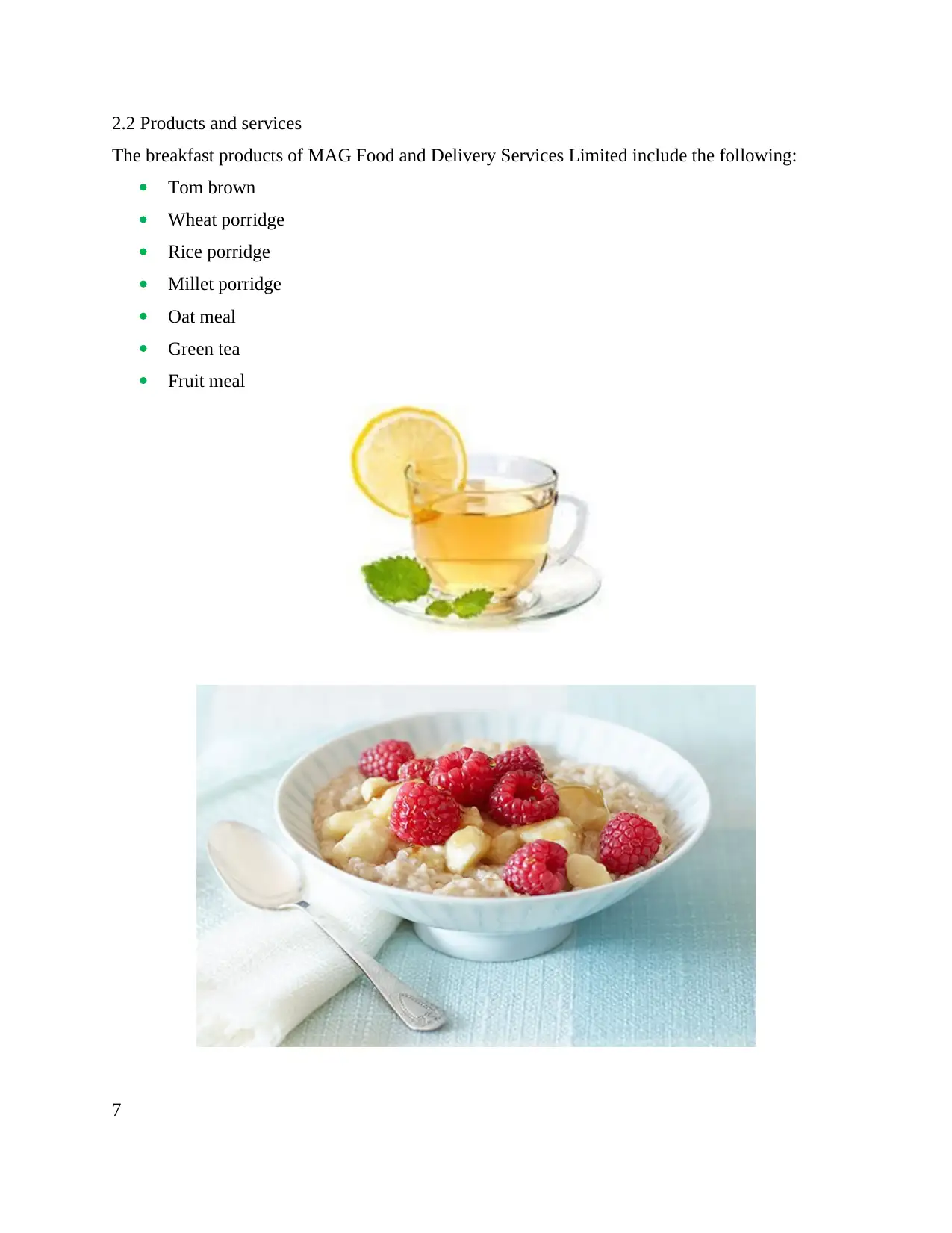
2.2 Products and services
The breakfast products of MAG Food and Delivery Services Limited include the following:
Tom brown
Wheat porridge
Rice porridge
Millet porridge
Oat meal
Green tea
Fruit meal
7
The breakfast products of MAG Food and Delivery Services Limited include the following:
Tom brown
Wheat porridge
Rice porridge
Millet porridge
Oat meal
Green tea
Fruit meal
7
Paraphrase This Document
Need a fresh take? Get an instant paraphrase of this document with our AI Paraphraser

8
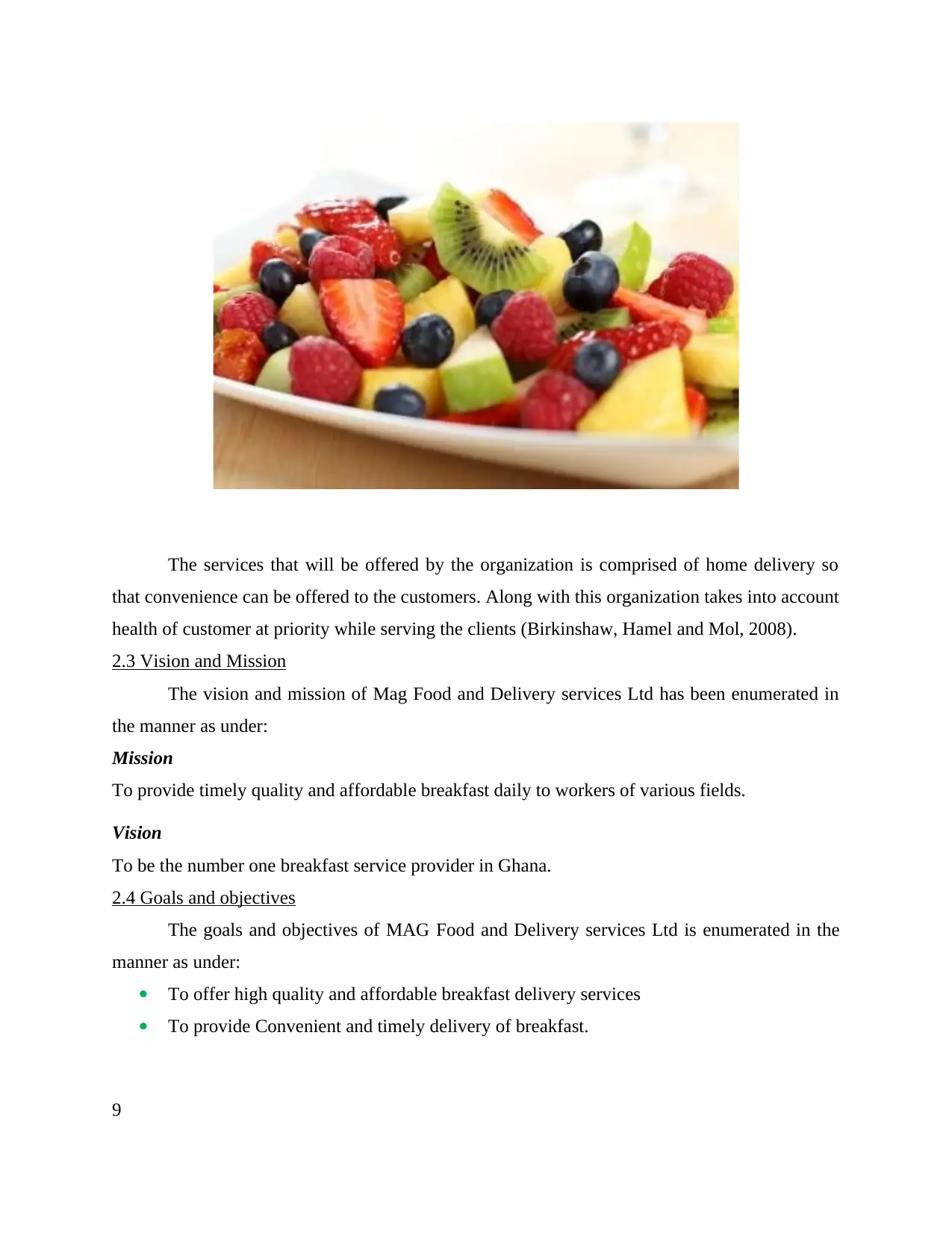
The services that will be offered by the organization is comprised of home delivery so
that convenience can be offered to the customers. Along with this organization takes into account
health of customer at priority while serving the clients (Birkinshaw, Hamel and Mol, 2008).
2.3 Vision and Mission
The vision and mission of Mag Food and Delivery services Ltd has been enumerated in
the manner as under:
Mission
To provide timely quality and affordable breakfast daily to workers of various fields.
Vision
To be the number one breakfast service provider in Ghana.
2.4 Goals and objectives
The goals and objectives of MAG Food and Delivery services Ltd is enumerated in the
manner as under:
To offer high quality and affordable breakfast delivery services
To provide Convenient and timely delivery of breakfast.
9
that convenience can be offered to the customers. Along with this organization takes into account
health of customer at priority while serving the clients (Birkinshaw, Hamel and Mol, 2008).
2.3 Vision and Mission
The vision and mission of Mag Food and Delivery services Ltd has been enumerated in
the manner as under:
Mission
To provide timely quality and affordable breakfast daily to workers of various fields.
Vision
To be the number one breakfast service provider in Ghana.
2.4 Goals and objectives
The goals and objectives of MAG Food and Delivery services Ltd is enumerated in the
manner as under:
To offer high quality and affordable breakfast delivery services
To provide Convenient and timely delivery of breakfast.
9
⊘ This is a preview!⊘
Do you want full access?
Subscribe today to unlock all pages.

Trusted by 1+ million students worldwide
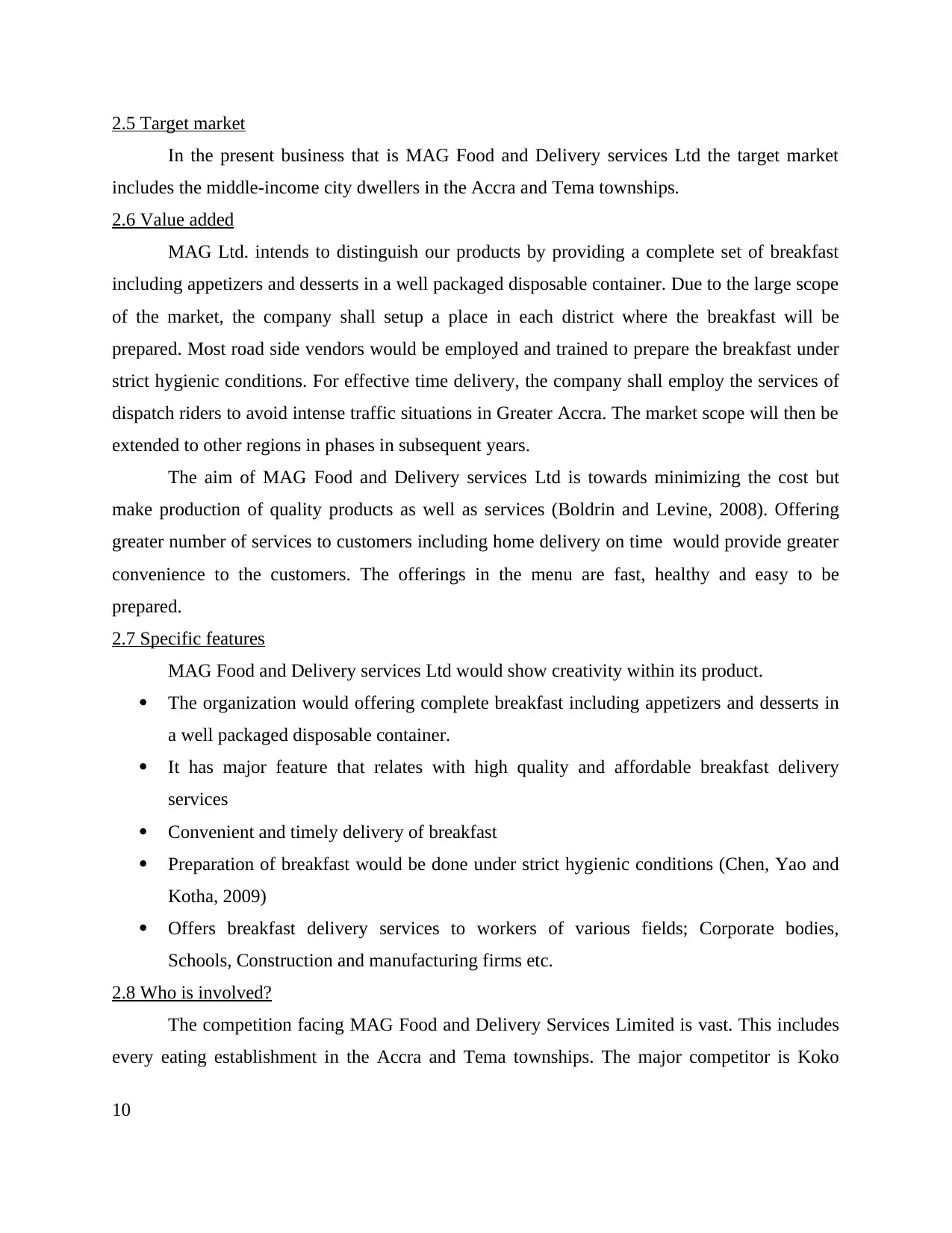
2.5 Target market
In the present business that is MAG Food and Delivery services Ltd the target market
includes the middle-income city dwellers in the Accra and Tema townships.
2.6 Value added
MAG Ltd. intends to distinguish our products by providing a complete set of breakfast
including appetizers and desserts in a well packaged disposable container. Due to the large scope
of the market, the company shall setup a place in each district where the breakfast will be
prepared. Most road side vendors would be employed and trained to prepare the breakfast under
strict hygienic conditions. For effective time delivery, the company shall employ the services of
dispatch riders to avoid intense traffic situations in Greater Accra. The market scope will then be
extended to other regions in phases in subsequent years.
The aim of MAG Food and Delivery services Ltd is towards minimizing the cost but
make production of quality products as well as services (Boldrin and Levine, 2008). Offering
greater number of services to customers including home delivery on time would provide greater
convenience to the customers. The offerings in the menu are fast, healthy and easy to be
prepared.
2.7 Specific features
MAG Food and Delivery services Ltd would show creativity within its product.
The organization would offering complete breakfast including appetizers and desserts in
a well packaged disposable container.
It has major feature that relates with high quality and affordable breakfast delivery
services
Convenient and timely delivery of breakfast
Preparation of breakfast would be done under strict hygienic conditions (Chen, Yao and
Kotha, 2009)
Offers breakfast delivery services to workers of various fields; Corporate bodies,
Schools, Construction and manufacturing firms etc.
2.8 Who is involved?
The competition facing MAG Food and Delivery Services Limited is vast. This includes
every eating establishment in the Accra and Tema townships. The major competitor is Koko
10
In the present business that is MAG Food and Delivery services Ltd the target market
includes the middle-income city dwellers in the Accra and Tema townships.
2.6 Value added
MAG Ltd. intends to distinguish our products by providing a complete set of breakfast
including appetizers and desserts in a well packaged disposable container. Due to the large scope
of the market, the company shall setup a place in each district where the breakfast will be
prepared. Most road side vendors would be employed and trained to prepare the breakfast under
strict hygienic conditions. For effective time delivery, the company shall employ the services of
dispatch riders to avoid intense traffic situations in Greater Accra. The market scope will then be
extended to other regions in phases in subsequent years.
The aim of MAG Food and Delivery services Ltd is towards minimizing the cost but
make production of quality products as well as services (Boldrin and Levine, 2008). Offering
greater number of services to customers including home delivery on time would provide greater
convenience to the customers. The offerings in the menu are fast, healthy and easy to be
prepared.
2.7 Specific features
MAG Food and Delivery services Ltd would show creativity within its product.
The organization would offering complete breakfast including appetizers and desserts in
a well packaged disposable container.
It has major feature that relates with high quality and affordable breakfast delivery
services
Convenient and timely delivery of breakfast
Preparation of breakfast would be done under strict hygienic conditions (Chen, Yao and
Kotha, 2009)
Offers breakfast delivery services to workers of various fields; Corporate bodies,
Schools, Construction and manufacturing firms etc.
2.8 Who is involved?
The competition facing MAG Food and Delivery Services Limited is vast. This includes
every eating establishment in the Accra and Tema townships. The major competitor is Koko
10
Paraphrase This Document
Need a fresh take? Get an instant paraphrase of this document with our AI Paraphraser
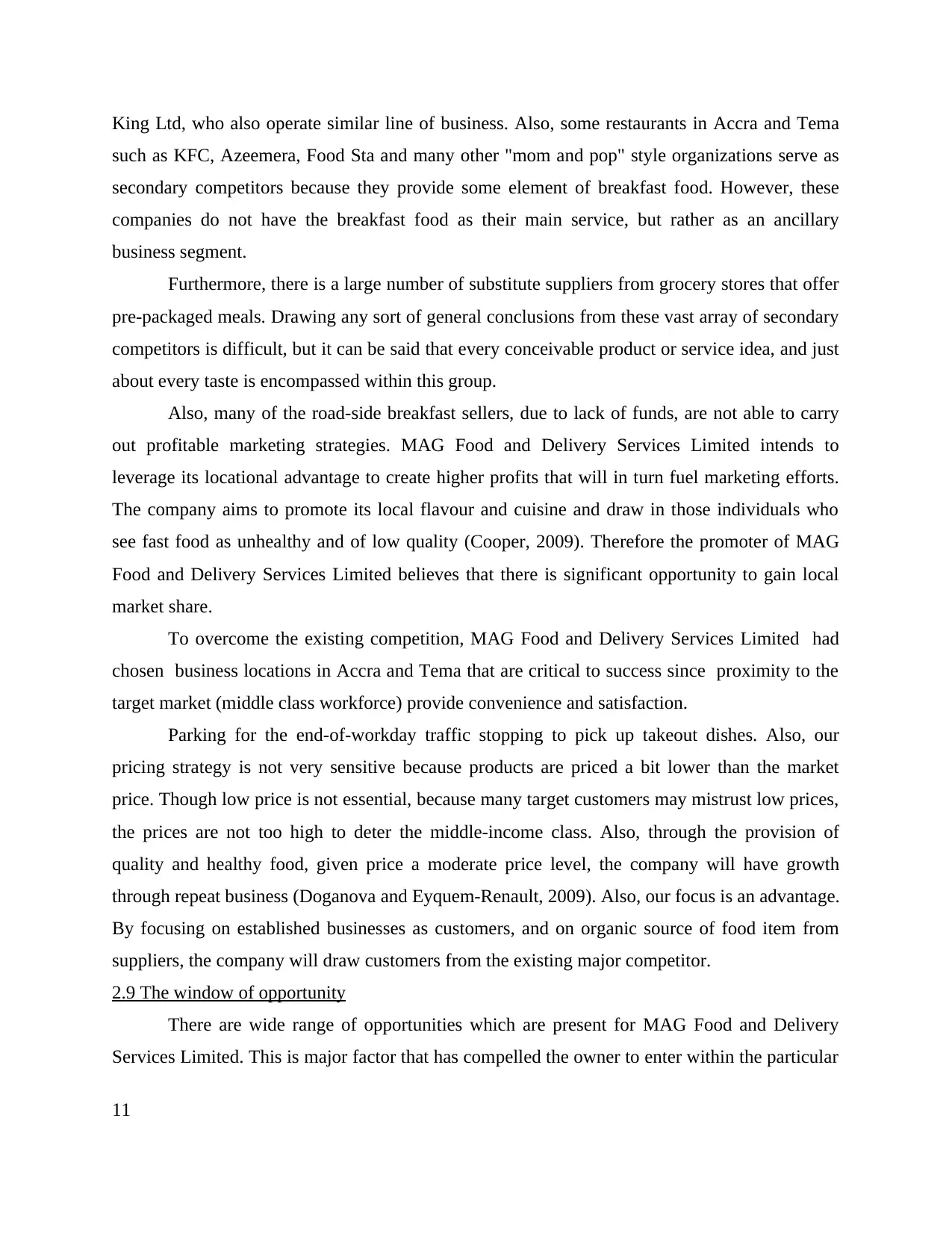
King Ltd, who also operate similar line of business. Also, some restaurants in Accra and Tema
such as KFC, Azeemera, Food Sta and many other "mom and pop" style organizations serve as
secondary competitors because they provide some element of breakfast food. However, these
companies do not have the breakfast food as their main service, but rather as an ancillary
business segment.
Furthermore, there is a large number of substitute suppliers from grocery stores that offer
pre-packaged meals. Drawing any sort of general conclusions from these vast array of secondary
competitors is difficult, but it can be said that every conceivable product or service idea, and just
about every taste is encompassed within this group.
Also, many of the road-side breakfast sellers, due to lack of funds, are not able to carry
out profitable marketing strategies. MAG Food and Delivery Services Limited intends to
leverage its locational advantage to create higher profits that will in turn fuel marketing efforts.
The company aims to promote its local flavour and cuisine and draw in those individuals who
see fast food as unhealthy and of low quality (Cooper, 2009). Therefore the promoter of MAG
Food and Delivery Services Limited believes that there is significant opportunity to gain local
market share.
To overcome the existing competition, MAG Food and Delivery Services Limited had
chosen business locations in Accra and Tema that are critical to success since proximity to the
target market (middle class workforce) provide convenience and satisfaction.
Parking for the end-of-workday traffic stopping to pick up takeout dishes. Also, our
pricing strategy is not very sensitive because products are priced a bit lower than the market
price. Though low price is not essential, because many target customers may mistrust low prices,
the prices are not too high to deter the middle-income class. Also, through the provision of
quality and healthy food, given price a moderate price level, the company will have growth
through repeat business (Doganova and Eyquem-Renault, 2009). Also, our focus is an advantage.
By focusing on established businesses as customers, and on organic source of food item from
suppliers, the company will draw customers from the existing major competitor.
2.9 The window of opportunity
There are wide range of opportunities which are present for MAG Food and Delivery
Services Limited. This is major factor that has compelled the owner to enter within the particular
11
such as KFC, Azeemera, Food Sta and many other "mom and pop" style organizations serve as
secondary competitors because they provide some element of breakfast food. However, these
companies do not have the breakfast food as their main service, but rather as an ancillary
business segment.
Furthermore, there is a large number of substitute suppliers from grocery stores that offer
pre-packaged meals. Drawing any sort of general conclusions from these vast array of secondary
competitors is difficult, but it can be said that every conceivable product or service idea, and just
about every taste is encompassed within this group.
Also, many of the road-side breakfast sellers, due to lack of funds, are not able to carry
out profitable marketing strategies. MAG Food and Delivery Services Limited intends to
leverage its locational advantage to create higher profits that will in turn fuel marketing efforts.
The company aims to promote its local flavour and cuisine and draw in those individuals who
see fast food as unhealthy and of low quality (Cooper, 2009). Therefore the promoter of MAG
Food and Delivery Services Limited believes that there is significant opportunity to gain local
market share.
To overcome the existing competition, MAG Food and Delivery Services Limited had
chosen business locations in Accra and Tema that are critical to success since proximity to the
target market (middle class workforce) provide convenience and satisfaction.
Parking for the end-of-workday traffic stopping to pick up takeout dishes. Also, our
pricing strategy is not very sensitive because products are priced a bit lower than the market
price. Though low price is not essential, because many target customers may mistrust low prices,
the prices are not too high to deter the middle-income class. Also, through the provision of
quality and healthy food, given price a moderate price level, the company will have growth
through repeat business (Doganova and Eyquem-Renault, 2009). Also, our focus is an advantage.
By focusing on established businesses as customers, and on organic source of food item from
suppliers, the company will draw customers from the existing major competitor.
2.9 The window of opportunity
There are wide range of opportunities which are present for MAG Food and Delivery
Services Limited. This is major factor that has compelled the owner to enter within the particular
11
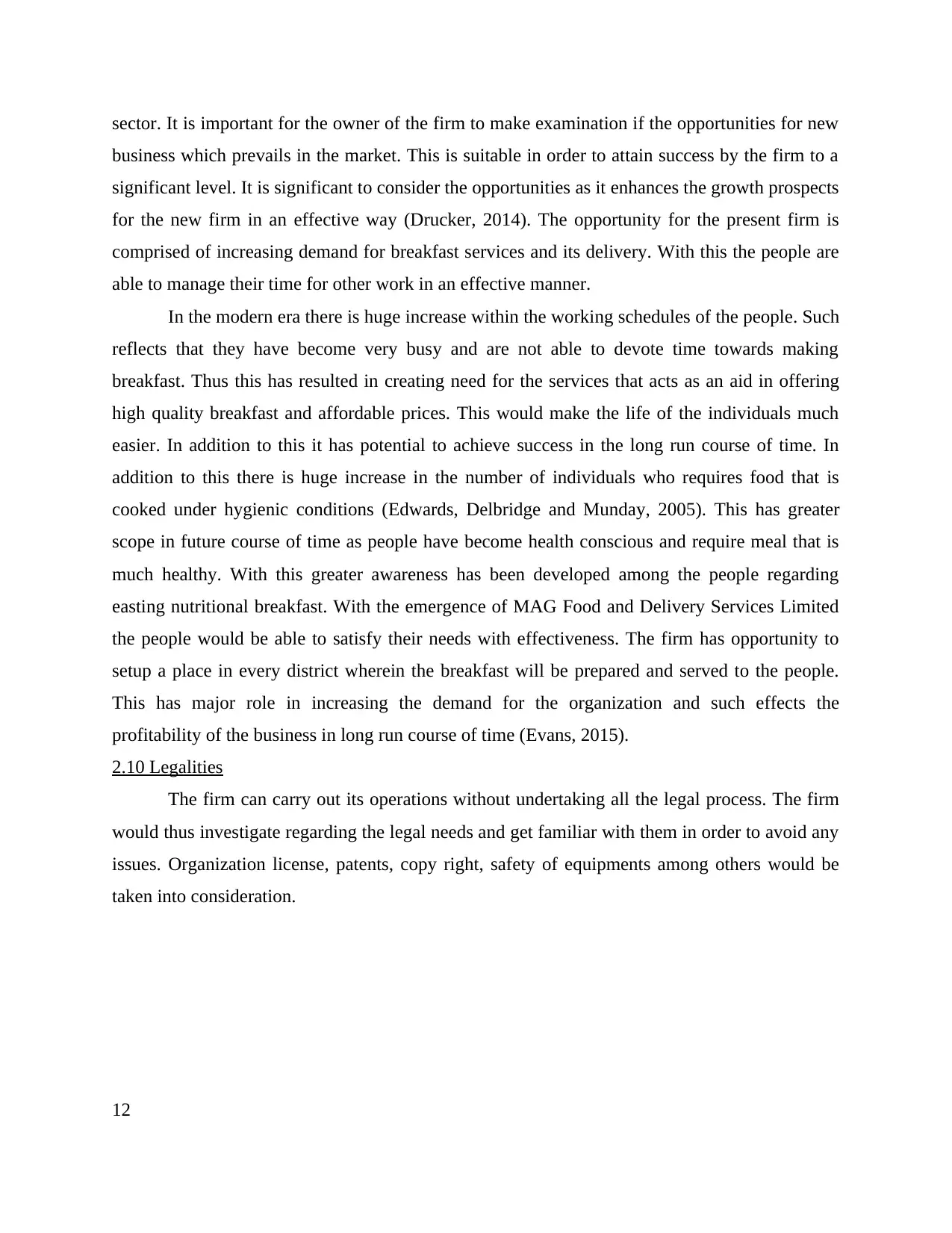
sector. It is important for the owner of the firm to make examination if the opportunities for new
business which prevails in the market. This is suitable in order to attain success by the firm to a
significant level. It is significant to consider the opportunities as it enhances the growth prospects
for the new firm in an effective way (Drucker, 2014). The opportunity for the present firm is
comprised of increasing demand for breakfast services and its delivery. With this the people are
able to manage their time for other work in an effective manner.
In the modern era there is huge increase within the working schedules of the people. Such
reflects that they have become very busy and are not able to devote time towards making
breakfast. Thus this has resulted in creating need for the services that acts as an aid in offering
high quality breakfast and affordable prices. This would make the life of the individuals much
easier. In addition to this it has potential to achieve success in the long run course of time. In
addition to this there is huge increase in the number of individuals who requires food that is
cooked under hygienic conditions (Edwards, Delbridge and Munday, 2005). This has greater
scope in future course of time as people have become health conscious and require meal that is
much healthy. With this greater awareness has been developed among the people regarding
easting nutritional breakfast. With the emergence of MAG Food and Delivery Services Limited
the people would be able to satisfy their needs with effectiveness. The firm has opportunity to
setup a place in every district wherein the breakfast will be prepared and served to the people.
This has major role in increasing the demand for the organization and such effects the
profitability of the business in long run course of time (Evans, 2015).
2.10 Legalities
The firm can carry out its operations without undertaking all the legal process. The firm
would thus investigate regarding the legal needs and get familiar with them in order to avoid any
issues. Organization license, patents, copy right, safety of equipments among others would be
taken into consideration.
12
business which prevails in the market. This is suitable in order to attain success by the firm to a
significant level. It is significant to consider the opportunities as it enhances the growth prospects
for the new firm in an effective way (Drucker, 2014). The opportunity for the present firm is
comprised of increasing demand for breakfast services and its delivery. With this the people are
able to manage their time for other work in an effective manner.
In the modern era there is huge increase within the working schedules of the people. Such
reflects that they have become very busy and are not able to devote time towards making
breakfast. Thus this has resulted in creating need for the services that acts as an aid in offering
high quality breakfast and affordable prices. This would make the life of the individuals much
easier. In addition to this it has potential to achieve success in the long run course of time. In
addition to this there is huge increase in the number of individuals who requires food that is
cooked under hygienic conditions (Edwards, Delbridge and Munday, 2005). This has greater
scope in future course of time as people have become health conscious and require meal that is
much healthy. With this greater awareness has been developed among the people regarding
easting nutritional breakfast. With the emergence of MAG Food and Delivery Services Limited
the people would be able to satisfy their needs with effectiveness. The firm has opportunity to
setup a place in every district wherein the breakfast will be prepared and served to the people.
This has major role in increasing the demand for the organization and such effects the
profitability of the business in long run course of time (Evans, 2015).
2.10 Legalities
The firm can carry out its operations without undertaking all the legal process. The firm
would thus investigate regarding the legal needs and get familiar with them in order to avoid any
issues. Organization license, patents, copy right, safety of equipments among others would be
taken into consideration.
12
⊘ This is a preview!⊘
Do you want full access?
Subscribe today to unlock all pages.

Trusted by 1+ million students worldwide
1 out of 53
Related Documents
Your All-in-One AI-Powered Toolkit for Academic Success.
+13062052269
info@desklib.com
Available 24*7 on WhatsApp / Email
![[object Object]](/_next/static/media/star-bottom.7253800d.svg)
Unlock your academic potential
Copyright © 2020–2025 A2Z Services. All Rights Reserved. Developed and managed by ZUCOL.





